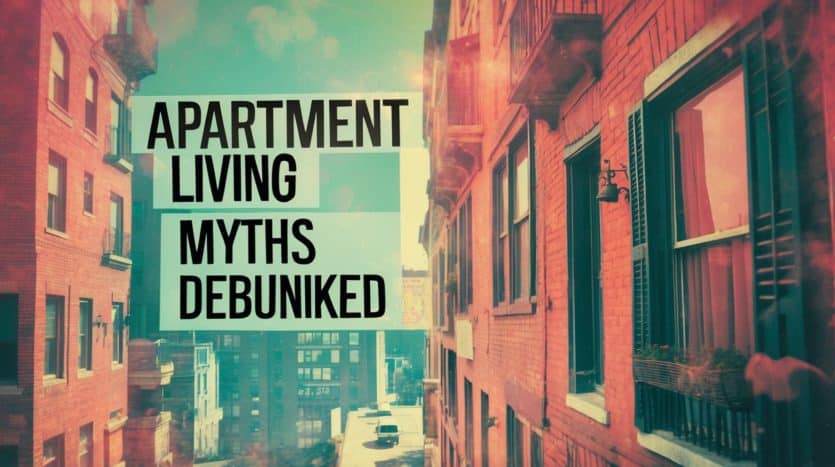Apartment Living Myths Debunked: What You Really Need to Know

Apartment Living Myths Debunked: What You Really Need to Know
Apartment living is a popular choice for many, offering flexibility and convenience. However, several common misconceptions surround this lifestyle, often deterring potential renters. This article debunks prevalent apartment living myths, providing a realistic picture and helping you make an informed decision.
Myth 1: Apartment Living is Always More Expensive Than Owning a Home
While homeownership might seem like the ultimate financial goal, the reality is that apartment living can be surprisingly affordable, especially in competitive housing markets. The initial down payment, closing costs, property taxes, and ongoing maintenance expenses associated with homeownership can significantly outweigh the monthly rent of an apartment, particularly in the short to medium term. A recent study by the National Association of Realtors showed that the median price of an existing home in 2024 was significantly higher than the average monthly rent for a comparable apartment in many urban areas. This disparity highlights how apartment living can be a more budget-friendly option, particularly for younger individuals or those with fluctuating incomes.
Myth 2: Apartments Lack Space and Privacy
The perception of cramped living spaces and a lack of privacy is a common misconception. Modern apartment complexes offer a wide range of floor plans, from studio apartments perfect for single individuals to spacious multi-bedroom units suitable for families. Furthermore, many newer buildings incorporate soundproofing technology and thoughtful architectural design to maximize privacy between units. For example, many high-end apartment buildings boast features like thick walls, double-paned windows, and strategically placed hallways, significantly reducing noise intrusion and enhancing privacy.
Myth 3: Apartment Living Means Sacrificing Outdoor Space
Many believe apartment living equates to limited or no access to outdoor space. This is far from the truth. Many modern apartment complexes feature a variety of amenities, including balconies, patios, rooftop gardens, and communal courtyards. These spaces provide opportunities for relaxation, socializing, and enjoying the outdoors without the responsibilities of maintaining a large yard. Consider apartment complexes with pet-friendly policies which often have designated dog parks or walking areas to provide additional outdoor space for you and your pet.
Myth 4: You Have No Control Over Renovations or Upgrades
While you can’t typically undertake major renovations in a rented apartment without the landlord’s permission, many landlords are willing to make upgrades or repairs if you make a reasonable request. Regular maintenance is typically the responsibility of the landlord, and they are often willing to address issues promptly to maintain the property’s value and the tenant’s satisfaction. Open communication with your landlord is vital. Before signing a lease, clearly discuss any necessary repairs or upgrades.
Myth 5: Apartment Living is Less Secure Than Homeownership
Apartment complexes often offer enhanced security measures, surpassing the typical security features found in single-family homes. Features such as secure entry systems, gated access, security cameras, and on-site security personnel contribute to a safer living environment. Furthermore, living in close proximity to neighbors can provide an additional layer of security and community watchfulness. However, it’s still important to take individual precautions to maintain personal safety regardless of your living situation.
Myth 6: Apartment Living Lacks Community
Contrary to popular belief, apartment living can foster a strong sense of community. Many complexes organize social events, creating opportunities for residents to interact and build relationships. Shared amenities like swimming pools, fitness centers, and communal areas act as natural meeting points, providing a chance for neighbors to connect. Furthermore, the close proximity of residents often leads to spontaneous interactions and a heightened sense of neighborhood camaraderie.
Myth 7: You’re Trapped in a Lease Agreement
While lease agreements are legally binding, they are designed to protect both the landlord and the tenant. Most leases are written for a specific term, commonly one year. However, with proper communication and understanding of the terms, it’s often possible to negotiate early termination or explore options for subletting. Some leases may have specific break-clause conditions. Carefully read the lease agreement and understand your options before signing.
Myth 8: Limited Parking Options
While parking availability can be a concern, especially in densely populated urban areas, many modern apartment buildings provide sufficient parking either included in the rent or as an add-on fee. Some complexes even offer covered parking or garages for an extra monthly cost. Always clarify parking arrangements before committing to a lease agreement.
Conclusion
Apartment living offers a flexible and often affordable alternative to homeownership. By dispelling these common myths, we hope to empower potential renters to make informed decisions based on their individual circumstances and priorities. While certain aspects of apartment living might not suit every lifestyle, its advantages are substantial, particularly for those seeking convenience, cost-effectiveness, and a vibrant community atmosphere. Remember that due diligence, clear communication, and a realistic understanding of expectations will significantly improve your apartment living experience.

